-

 Fascinating vintage photograph of a Dublin City Centre Wall totally given over to yesteryear advertising posters.A horse and cart can be seen adjacent .Some of the products and companies being advertised include institutions long closed including-Manders Dublin Ale,Phoenix Brewery,Cooneys Blackening,Pooles, Also posters advertising a sports day in Ballsbridge and rosaries for mixed marriages ! Robert Manders & Co, New Brewery, 113 James Street, Dublin, Ireland. Established 1800 and registered in 1882. Association with the Phoenix Brewery (Dublin) Ltd. was terminated in 1897 and carried on though restricted to ale brewing until c.1907. From:-The Breweries and Distilleries in Dublin In 1862 Robert Manders & Co brewery occupied 111-113 at the north side of James Street. The concern was also the business address of the Manders family. Alfred of Flesk Priory, Killarney, Frederick of Belfield, Roebuck, Richard of Brackenstown, Swords, Robert of Landscape, Dundrum, Herbert of Obelisk Park, Blackrock, Richard of Shanganagh, Bray, and Robert Geoghegan of Carysfort, Stillorgan. Apart from the brewery they had flour mills at Islandbridge and bakeries at Fownes Street, Moore Street, Church Street, Camden Street, and Baggot Street. The brewery continued until 1909. Phoenix Brewery (Dublin) Ltd, 89 James's Street, Dublin, Ireland. Founded 1778 and was later known as the Phoenix Porter Brewery Co. Registered January 1897. Acquired by John D'Arcy & Son Ltd 1906 and closed 1909. From the Brewery History society Journal Number 91 This brewery publicly advertised itself as "the largest brewery in Ireland but one". Founded in 1788 by Charles Madder who by all accounts was a brilliant technical and innovative brewer. He had come from London to brew porter in Dublin. His business and trading activities were poor and the brewery was rescued by one John Brennan and later his son Charles. Essentially a porter brewery with a capacity to produce 350,000 bulk barrels per annum, it launched its own O'Connell's Dublin Ale. This was probably due to the fact that when they took over Robert Manders & Co's Brewery, their next door neighbours in 1897 it replaced Mander's Dublin Ale. It enjoyed a local and export trade however for whatever the reasons it became bankrupt and closed in 1909. The franchise of brewing O'Connell's Dublin Ale was given to D'Arcys. From:- Breweries and Distilleries in Dublin Francis Coleman moved from 103 to 105 James Street on 15-8-1807. At that time Francis Coleman & Hamilton dissolved their brewing partnership. The Guinness Power station site (now Roe & Co distillery) near the corner of Watling Street occupied part of the site of the Phoenix brewery founded in 1778 by an English brewer called Mather. In 1828 John Brennan bought the brewery and was succeeded by Charles Brenan. Daniel O’Connell junior son of the Liberator acquired the Phoenix Brewery in 1831 which occupies a three acre site at the corner of Watling Street and James’s Street. It operated under the name O’Connell’s brewery for a time. There was a campaign to support their porter as “Catholic” against Guinnness’s “protestant porter“. Daniel O’Connell, the Liberator, refused to support that activity while he was an MP. Guinness was a political rival but was quite liberal on the Catholic Emancipation and Repeal questions. Phoenix acquired the adjoining the six acre Manders brewery site at 111-117 James’s Street and in 1897 the concern became a public company. The brewery extended from James Street to the Quays and had the second largest output in Ireland. John D'Arcy & Son Ltd’s Anchor Brewery bought the Phoenix brewery, then operating for 160 years on 13-6-1905 and it was hoped to continue both breweries as well as the Phoenix brand O’Connell’s ale. However by 13-10-1905 the Phoenix site was for auction. Cooneys Blacking in Penny Boxes: Blacking (polish), a nineteenth-century shoe polish Younger's Brewery (William Younger & Company) was a brewery in Edinburgh which grew from humble beginnings in 1749 to become one of the city’s main commercial enterprises, supplying domestic and foreign markets. It should not be confused with another, less renowned Edinburgh brewery, that of Robert Younger, who also brewed in Holyrood at the St. Ann's Brewery or that of George Younger, who brewed in Alloa. In 1931 Younger's merged with McEwan’s to form Scottish Brewers, which in turn merged with Newcastle Breweries in 1960 to form Scottish & Newcastle. By the late 1960s the combine employed the largest single workforce in the city
Fascinating vintage photograph of a Dublin City Centre Wall totally given over to yesteryear advertising posters.A horse and cart can be seen adjacent .Some of the products and companies being advertised include institutions long closed including-Manders Dublin Ale,Phoenix Brewery,Cooneys Blackening,Pooles, Also posters advertising a sports day in Ballsbridge and rosaries for mixed marriages ! Robert Manders & Co, New Brewery, 113 James Street, Dublin, Ireland. Established 1800 and registered in 1882. Association with the Phoenix Brewery (Dublin) Ltd. was terminated in 1897 and carried on though restricted to ale brewing until c.1907. From:-The Breweries and Distilleries in Dublin In 1862 Robert Manders & Co brewery occupied 111-113 at the north side of James Street. The concern was also the business address of the Manders family. Alfred of Flesk Priory, Killarney, Frederick of Belfield, Roebuck, Richard of Brackenstown, Swords, Robert of Landscape, Dundrum, Herbert of Obelisk Park, Blackrock, Richard of Shanganagh, Bray, and Robert Geoghegan of Carysfort, Stillorgan. Apart from the brewery they had flour mills at Islandbridge and bakeries at Fownes Street, Moore Street, Church Street, Camden Street, and Baggot Street. The brewery continued until 1909. Phoenix Brewery (Dublin) Ltd, 89 James's Street, Dublin, Ireland. Founded 1778 and was later known as the Phoenix Porter Brewery Co. Registered January 1897. Acquired by John D'Arcy & Son Ltd 1906 and closed 1909. From the Brewery History society Journal Number 91 This brewery publicly advertised itself as "the largest brewery in Ireland but one". Founded in 1788 by Charles Madder who by all accounts was a brilliant technical and innovative brewer. He had come from London to brew porter in Dublin. His business and trading activities were poor and the brewery was rescued by one John Brennan and later his son Charles. Essentially a porter brewery with a capacity to produce 350,000 bulk barrels per annum, it launched its own O'Connell's Dublin Ale. This was probably due to the fact that when they took over Robert Manders & Co's Brewery, their next door neighbours in 1897 it replaced Mander's Dublin Ale. It enjoyed a local and export trade however for whatever the reasons it became bankrupt and closed in 1909. The franchise of brewing O'Connell's Dublin Ale was given to D'Arcys. From:- Breweries and Distilleries in Dublin Francis Coleman moved from 103 to 105 James Street on 15-8-1807. At that time Francis Coleman & Hamilton dissolved their brewing partnership. The Guinness Power station site (now Roe & Co distillery) near the corner of Watling Street occupied part of the site of the Phoenix brewery founded in 1778 by an English brewer called Mather. In 1828 John Brennan bought the brewery and was succeeded by Charles Brenan. Daniel O’Connell junior son of the Liberator acquired the Phoenix Brewery in 1831 which occupies a three acre site at the corner of Watling Street and James’s Street. It operated under the name O’Connell’s brewery for a time. There was a campaign to support their porter as “Catholic” against Guinnness’s “protestant porter“. Daniel O’Connell, the Liberator, refused to support that activity while he was an MP. Guinness was a political rival but was quite liberal on the Catholic Emancipation and Repeal questions. Phoenix acquired the adjoining the six acre Manders brewery site at 111-117 James’s Street and in 1897 the concern became a public company. The brewery extended from James Street to the Quays and had the second largest output in Ireland. John D'Arcy & Son Ltd’s Anchor Brewery bought the Phoenix brewery, then operating for 160 years on 13-6-1905 and it was hoped to continue both breweries as well as the Phoenix brand O’Connell’s ale. However by 13-10-1905 the Phoenix site was for auction. Cooneys Blacking in Penny Boxes: Blacking (polish), a nineteenth-century shoe polish Younger's Brewery (William Younger & Company) was a brewery in Edinburgh which grew from humble beginnings in 1749 to become one of the city’s main commercial enterprises, supplying domestic and foreign markets. It should not be confused with another, less renowned Edinburgh brewery, that of Robert Younger, who also brewed in Holyrood at the St. Ann's Brewery or that of George Younger, who brewed in Alloa. In 1931 Younger's merged with McEwan’s to form Scottish Brewers, which in turn merged with Newcastle Breweries in 1960 to form Scottish & Newcastle. By the late 1960s the combine employed the largest single workforce in the city -

 26cm (empty)
26cm (empty)Bunratty Mead is a traditional wine, produced from an ancient Irish recipe of pure honey, fruit of the vine and natural herbs. It's a medium sweet wine, with a wide taste appeal, and suitable for all important occasions. As the drink of the ancient Celts, Mead derives much of its appeal through Irish Folklore, which is legendary of this mystical drink with strong attachments to Ireland.
In the days of old when knights were bold, the drink of choice was mead. Much more than an extraordinary legendary drink with strong attachments to Ireland, mead can be traced back as many centuries before Christ. It became the chief drink of the Irish and was often referred to in Gaelic poetry. Mead's influence was so great that the halls of Tara, where the High Kings of Ireland ruled, were called the house of the Mead Circle. Its fame spread quickly and soon a medieval banquet was not complete without it.


Even the church recognised the value of this fabulous drink. Legend has it that St. Finian lived for six days a week on bread and water, but on Sundays ate salmon and drank a full sup of mead. In addition, St. Bridget performed a miracle when mead could not be located for the king of Leinster. She blessed an empty vessel, which miraculously filled with Mead.

-

 33cm x 38cm Co Kerry Stumbling upon an old suitcase, we discovered a cache of wonderful old bullheads,return dockets, invoices and other commercial ephemera from the late 1920's and 1930's.They originated from a now closed licensed premises-Courtney's of Castlegregory Co Kerry-situated on the Dingle Peninsula not far from the start of the Connor Pass. We then decided to out them to best use by making framed display collages using the original items and have also included some original Guinness bottle labels from around the country to add a little more historical flavour ! A truly unique and unusual piece of Irish Pub Memorabilia which can only appreciate in value over the years given they are already heading for a century old. Each display is different to the next also adding to their rarity value- a truly once off item for any proud Irish Pub or home bar !
33cm x 38cm Co Kerry Stumbling upon an old suitcase, we discovered a cache of wonderful old bullheads,return dockets, invoices and other commercial ephemera from the late 1920's and 1930's.They originated from a now closed licensed premises-Courtney's of Castlegregory Co Kerry-situated on the Dingle Peninsula not far from the start of the Connor Pass. We then decided to out them to best use by making framed display collages using the original items and have also included some original Guinness bottle labels from around the country to add a little more historical flavour ! A truly unique and unusual piece of Irish Pub Memorabilia which can only appreciate in value over the years given they are already heading for a century old. Each display is different to the next also adding to their rarity value- a truly once off item for any proud Irish Pub or home bar ! -

 Thomas Power (1856-1930) was the first chairman of Waterford County Council and was chairman of Dungarvan Town Commissioners on a number of occasions. In the 1880s he was in partnership with his brother producing mineral waters. In 1904 he began producing his award winning Blackwater Cider. In 1917 Thomas purchased the old St Brigid's Well Brewery in Fair Lane, Dungarvan from the Marquis of Waterford. The business was a great success and its produce was in demand all over County Waterford and beyond. After his death the brewery was taken over by his son Paul I. Power who managed it until 1976 when his son Ion took over. Brewing took place in Dungarvan throughout history but we only have detailed information from the late 18th century onwards. In 1917 the Marquis sold the property and it was acquired by Thomas Power. He developed a thriving business known as Power's Brewery. This brewing tradition continues into the modern era with the Dungarvan Brewing Company.
Thomas Power (1856-1930) was the first chairman of Waterford County Council and was chairman of Dungarvan Town Commissioners on a number of occasions. In the 1880s he was in partnership with his brother producing mineral waters. In 1904 he began producing his award winning Blackwater Cider. In 1917 Thomas purchased the old St Brigid's Well Brewery in Fair Lane, Dungarvan from the Marquis of Waterford. The business was a great success and its produce was in demand all over County Waterford and beyond. After his death the brewery was taken over by his son Paul I. Power who managed it until 1976 when his son Ion took over. Brewing took place in Dungarvan throughout history but we only have detailed information from the late 18th century onwards. In 1917 the Marquis sold the property and it was acquired by Thomas Power. He developed a thriving business known as Power's Brewery. This brewing tradition continues into the modern era with the Dungarvan Brewing Company. -
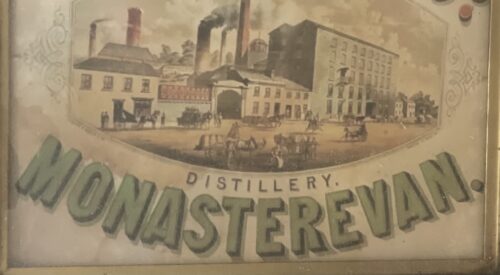
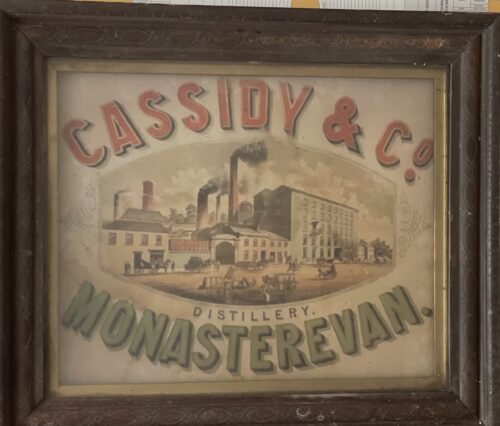 67cm x 56cm
67cm x 56cmIn 1784 Monasterevin Distillery was opened by Mr. John Cassidy. A hundred years later, in 1884 the distillery was making 250,000 gallons of whiskey a year. It was said that the "Cassidy whiskey was the best whiskey in the country".
Some of the whiskey was exported to London. It was transported to Dublin on canal boats and then shipped to England from Dublin Port. A brewery for making beer was later opened in 1860. Cassidy's Distillery and Brewery closed in 1934.
The Cassidy Family lived in Monasterevin House. They were friendly with Gerard Manley Hopkins, the famous poet. He stayed with them when he visited Monasterevin.
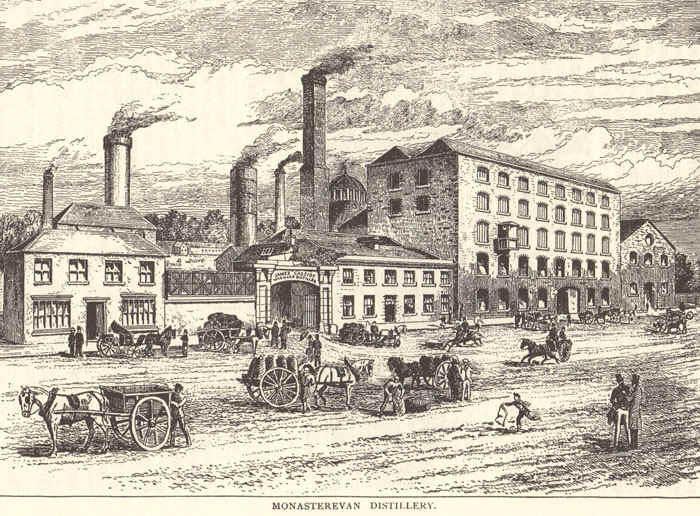
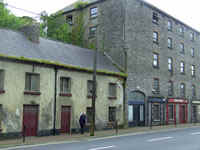
-
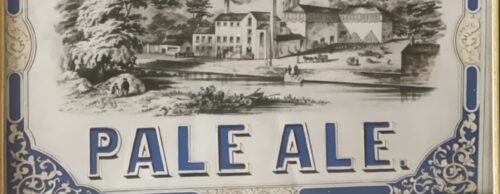
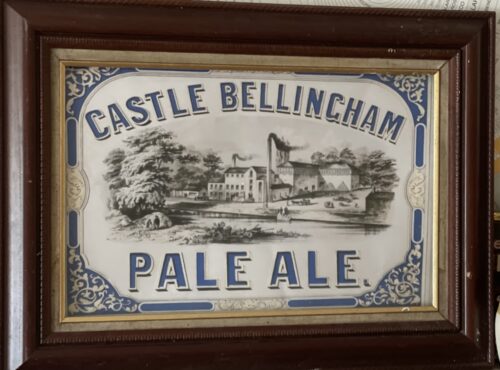 74cm x 52cm ANOTHER great industry on the Scotch Hall site was the brewing firm of Cairnes Ltd, one of the original firms of Irish brewers dating back to 1772 with the foundation of the Castlebellingham Brewery at the picturesque Co Louth village of that name.In 1825, William Cairnes, who was related by marriage to the owners of the ’Bellingham brewery, founded the brewery at Marsh Road, Drogheda, which, for over 150 years, gave employment to almost 200 workers and the firm was famous for its ales and stout. In 1889 the interests of the two breweries were pooled, a public company being formed under the title of the Castlebellingham and Drogheda Breweries Ltd. This title was changed for brevity in 1933 to Cairnes Ltd. For a good many years subsequent to the merger, the breweries were worked independently, each supplying its own customers throughout Ireland and abroad. However, in 1923, it was considered advisable to concentrate brewing in Drogheda, owing to the more advantageous position of the town, and the brewing plant and premises there, were more extensive. Actually the plant at Drogheda was one of the most up-to-date in Ireland and compared very favourably with that of breweries in England and Wales. The supply of brewing water was obtained from a 400ft deep artesian well on the company’s premises. (I wonder if it is still there) and this water was used with the choicest hops and malt made from the best Irish barley obtainable. The hops used came chiefly from Kent and when obtainable, a percentage came from the USA. The process through which the barley went from its arrival in the brewery until it emerged as ale or stout, was extremely interesting and quaint. The barley was first dried to a consistent level of moisture content and then stored for a few weeks before being steeped. It was then ‘floored’ on lots which the brewery had, as well as lofts in Dominic Street and Wellington Quay. These have, in recent years, been converted into shops and a high rise apartment block. Here on these lofts the growing process of the barley in the ground was artificially repeated, the growth however being terminated at the desired stage. The barley was then kilned and cured before being ground and mashed with hot water and the liquid was drawn off. It was then run to built-in coppers, where hops was added, then boiled, the wort, as it was called, being subsequently strained from the hops, cooled and fermented. The final stage was when the beer was casked (in wooden barrels) and matured. Altogether there were approximately 200 people employed in the industry, for apart from the actual brewing of the beer there was a tremendous amount of activity, and the transport department built up a fine fleet of steam lorries, (I remember seeing Gerry McConville driving one of these down the Marsh Road), motor lorries and carts and Jemmy Early was in charge of town deliveries in a horse drawn wagon, from which he rolled the barrells into the pub. While catering for an extensive home market, Cairnes Ltd had, since May 1951, been engaged in the export of bottled stout to America. This stout was much stronger than anything of its kind on sale in Ireland and the venture steadily expanded in the new market. The metal caps of the export bottles had the imprint of the Star and Crescent, which is part of the Drogheda Coat of Arms, while the label carried three reproductions of miniature photographs of St Laurence Gate. And so one of Drogheda’s oldest industries was carrying the name of the town across the world. In Millmount museum there is a permanent exhibition of artifacts from Cairnes Brewery which were literally ‘rescued’ before and during the closing down of the brewery in 1965 when Guinness started buying out their competitors.Showcased are the various bottles with their beer labels – the famous ‘Stingo’, a most favoured ale at the time. There are also the large enamel advertising signs with ‘W Cairnes and Son. X Porter’ showing the brewery in its heyday, and a complete set of tools which were used by the cooper (wooden barrel maker), with a mythology of names like, the adze, draw knife, the buzz, the auger and chisel, the spokeshave and the coopers anvil. Note: A recent informant who wishes to remain anonymous, wrote the following about Cairnes Brewery: ‘The last brew was carried out in October 1960. The brew was mashed by Joseph Oliver Roche, head brewer and declared by Patrick (Paddy) Weldon. ‘In the break-up of the Brewery by Guinness, Roche was sent to Waterford, while Weldon was sent to Dundalk. Kevin Beatty was also sent to New Ross or was it Enniscorthy?’
74cm x 52cm ANOTHER great industry on the Scotch Hall site was the brewing firm of Cairnes Ltd, one of the original firms of Irish brewers dating back to 1772 with the foundation of the Castlebellingham Brewery at the picturesque Co Louth village of that name.In 1825, William Cairnes, who was related by marriage to the owners of the ’Bellingham brewery, founded the brewery at Marsh Road, Drogheda, which, for over 150 years, gave employment to almost 200 workers and the firm was famous for its ales and stout. In 1889 the interests of the two breweries were pooled, a public company being formed under the title of the Castlebellingham and Drogheda Breweries Ltd. This title was changed for brevity in 1933 to Cairnes Ltd. For a good many years subsequent to the merger, the breweries were worked independently, each supplying its own customers throughout Ireland and abroad. However, in 1923, it was considered advisable to concentrate brewing in Drogheda, owing to the more advantageous position of the town, and the brewing plant and premises there, were more extensive. Actually the plant at Drogheda was one of the most up-to-date in Ireland and compared very favourably with that of breweries in England and Wales. The supply of brewing water was obtained from a 400ft deep artesian well on the company’s premises. (I wonder if it is still there) and this water was used with the choicest hops and malt made from the best Irish barley obtainable. The hops used came chiefly from Kent and when obtainable, a percentage came from the USA. The process through which the barley went from its arrival in the brewery until it emerged as ale or stout, was extremely interesting and quaint. The barley was first dried to a consistent level of moisture content and then stored for a few weeks before being steeped. It was then ‘floored’ on lots which the brewery had, as well as lofts in Dominic Street and Wellington Quay. These have, in recent years, been converted into shops and a high rise apartment block. Here on these lofts the growing process of the barley in the ground was artificially repeated, the growth however being terminated at the desired stage. The barley was then kilned and cured before being ground and mashed with hot water and the liquid was drawn off. It was then run to built-in coppers, where hops was added, then boiled, the wort, as it was called, being subsequently strained from the hops, cooled and fermented. The final stage was when the beer was casked (in wooden barrels) and matured. Altogether there were approximately 200 people employed in the industry, for apart from the actual brewing of the beer there was a tremendous amount of activity, and the transport department built up a fine fleet of steam lorries, (I remember seeing Gerry McConville driving one of these down the Marsh Road), motor lorries and carts and Jemmy Early was in charge of town deliveries in a horse drawn wagon, from which he rolled the barrells into the pub. While catering for an extensive home market, Cairnes Ltd had, since May 1951, been engaged in the export of bottled stout to America. This stout was much stronger than anything of its kind on sale in Ireland and the venture steadily expanded in the new market. The metal caps of the export bottles had the imprint of the Star and Crescent, which is part of the Drogheda Coat of Arms, while the label carried three reproductions of miniature photographs of St Laurence Gate. And so one of Drogheda’s oldest industries was carrying the name of the town across the world. In Millmount museum there is a permanent exhibition of artifacts from Cairnes Brewery which were literally ‘rescued’ before and during the closing down of the brewery in 1965 when Guinness started buying out their competitors.Showcased are the various bottles with their beer labels – the famous ‘Stingo’, a most favoured ale at the time. There are also the large enamel advertising signs with ‘W Cairnes and Son. X Porter’ showing the brewery in its heyday, and a complete set of tools which were used by the cooper (wooden barrel maker), with a mythology of names like, the adze, draw knife, the buzz, the auger and chisel, the spokeshave and the coopers anvil. Note: A recent informant who wishes to remain anonymous, wrote the following about Cairnes Brewery: ‘The last brew was carried out in October 1960. The brew was mashed by Joseph Oliver Roche, head brewer and declared by Patrick (Paddy) Weldon. ‘In the break-up of the Brewery by Guinness, Roche was sent to Waterford, while Weldon was sent to Dundalk. Kevin Beatty was also sent to New Ross or was it Enniscorthy?’ -

 47cm x 37cm Limerick The building itself it is a terraced eight-bay four-storey late-Victorian commercial building, It was built across 1895 and 1896 for J McCarthy and Sons, Wholesale Tea and Wine Merchants. Named the Clancarty (family of Carty) Buildings, the building was designed by architect and built by John Delaney. The Cork Examiner on 10 August 1896 (p.9) describes the impressive building: “No person passing through George’s street, can fail to see and admire the beautiful structure, which has just been completed. The facade is 54 feet long and 48 feet high, divided into four storeys, with round headed windows in the classic style, and extends more than the whole length of George’s Street, as between Cook street and Marlboro Street. The ground floor is divided by handsome wrought pilasters and consoles, each console decorated with floral swags, with a richly-moulded dental cornice immediately over the facia. This basement is perfectly fire proof, the walls being built of brick and cement, whilst the ceiling and floor over are composed of a solid block of concrete. The first, second and third floors immediately overhead are altogether occupied by the firm as warerooms to meet the requirements of their immense business as tea and wine merchants and whiskey shippers, the growth of which necessitates this great extension of their premises”.
47cm x 37cm Limerick The building itself it is a terraced eight-bay four-storey late-Victorian commercial building, It was built across 1895 and 1896 for J McCarthy and Sons, Wholesale Tea and Wine Merchants. Named the Clancarty (family of Carty) Buildings, the building was designed by architect and built by John Delaney. The Cork Examiner on 10 August 1896 (p.9) describes the impressive building: “No person passing through George’s street, can fail to see and admire the beautiful structure, which has just been completed. The facade is 54 feet long and 48 feet high, divided into four storeys, with round headed windows in the classic style, and extends more than the whole length of George’s Street, as between Cook street and Marlboro Street. The ground floor is divided by handsome wrought pilasters and consoles, each console decorated with floral swags, with a richly-moulded dental cornice immediately over the facia. This basement is perfectly fire proof, the walls being built of brick and cement, whilst the ceiling and floor over are composed of a solid block of concrete. The first, second and third floors immediately overhead are altogether occupied by the firm as warerooms to meet the requirements of their immense business as tea and wine merchants and whiskey shippers, the growth of which necessitates this great extension of their premises”.
J McCarthy and Sons, Wholesale Tea and Wine Merchants as shown in Goads Insurance Map of Cork, 1906 (source: Kieran McCarthy) 
Description of Clancarty Buildings, Cork Examiner, 10 August 1896, p.9 (source: Cork City Library) -

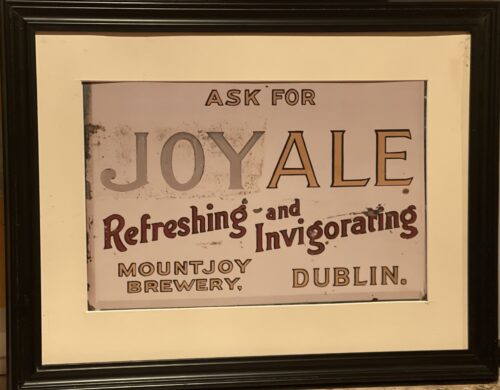 44cm x 52cmMountjoy Brewery Ltd, Russell Street, Dublin, Ireland. Founded 1852. Known as Findlater & Co. until June 1891. Closed 1957. From the Brewery History society Journal Number 91 Founded by Alexander Findlater, a Scottish businessman, in 1852. Primarily a porter brewer but later ale brewers. They enjoyed local, military and export trade with markets in the UK and the colonies. The brewery passed into the hands of Messrs Malone & Blood in 1900 and had by this time become the largest exporter of porter next to Guinness through the port of Dublin. It outlived all its rivals in Dublin apart from Guinness and closed in 1957.
44cm x 52cmMountjoy Brewery Ltd, Russell Street, Dublin, Ireland. Founded 1852. Known as Findlater & Co. until June 1891. Closed 1957. From the Brewery History society Journal Number 91 Founded by Alexander Findlater, a Scottish businessman, in 1852. Primarily a porter brewer but later ale brewers. They enjoyed local, military and export trade with markets in the UK and the colonies. The brewery passed into the hands of Messrs Malone & Blood in 1900 and had by this time become the largest exporter of porter next to Guinness through the port of Dublin. It outlived all its rivals in Dublin apart from Guinness and closed in 1957.Entry in the Trade Mark Registry Registration No : 5,664 Description : Three castles in shield Date of Application : 13/5/1876 Used Prior to 1875? : 10 years
Registration No : 5,665 Description : Crown in shield Date of Application : 13/5/1876 Used Prior to 1875? : 10 years Registration No : 156,739 Description : Label design Date of Application : 26/5/1891 Used Prior to 1875? : Since Aug 1875 Registration No : 372,597 Description : Joy (word) Date of Application : 19/04/1916 Used Prior to 1875? : NO -
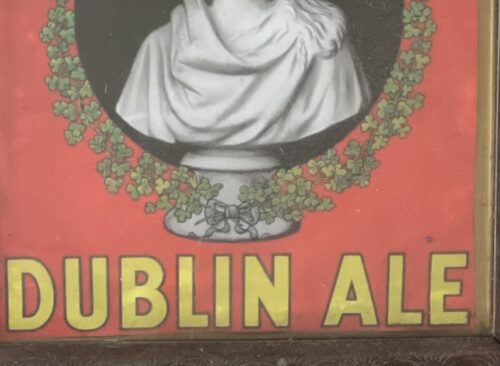
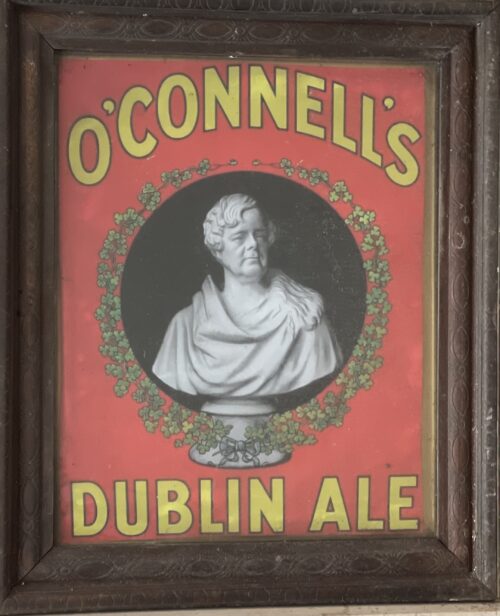 67cm x 56cm
67cm x 56cmDaniel O’Connnell Jr. had famously acquired the Phoenix Brewery in James’s street in 1831, which produced O’Connell’s Ale. It should be noted that O’Connell and the Guinness family were at times political rivals, something best captured by the 1841 ‘Repeal Election’, where O’Connell had stood against and defeated Arthur Guinness Jr. This period would see a sizeable boycott of Guinness, dubbed “Protestant Porter” by sections of the populace, though this was against the wishes of O’Connell himself.
John D’Arcy continued to brew O’Connell Ale after the family had ceased their role in brewing, and in time production moved to the Anchor Brewery in Usher Street. Watkins eventually took up the brewing of O’Connell Ale, and this advertisement was placed by them in the pages of leading newspapers in the 1930s.
While Arthur had failed to defeat O’Connell at the Ballot Box, I always wonder what O’Connell would think of the Guinness Empire today every time I see a Diaego truck pass his statue.
-

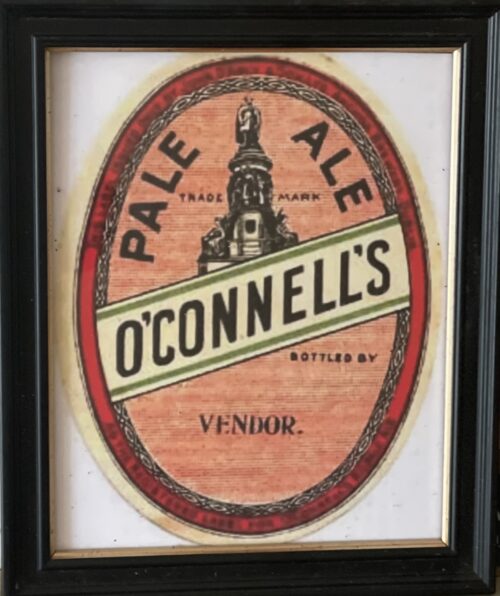 32cm x 27cm
32cm x 27cmDaniel O’Connnell Jr. had famously acquired the Phoenix Brewery in James’s street in 1831, which produced O’Connell’s Ale. It should be noted that O’Connell and the Guinness family were at times political rivals, something best captured by the 1841 ‘Repeal Election’, where O’Connell had stood against and defeated Arthur Guinness Jr. This period would see a sizeable boycott of Guinness, dubbed “Protestant Porter” by sections of the populace, though this was against the wishes of O’Connell himself.
John D’Arcy continued to brew O’Connell Ale after the family had ceased their role in brewing, and in time production moved to the Anchor Brewery in Usher Street. Watkins eventually took up the brewing of O’Connell Ale, and this advertisement was placed by them in the pages of leading newspapers in the 1930s.
While Arthur had failed to defeat O’Connell at the Ballot Box, I always wonder what O’Connell would think of the Guinness Empire today every time I see a Diaego truck pass his statue.
-
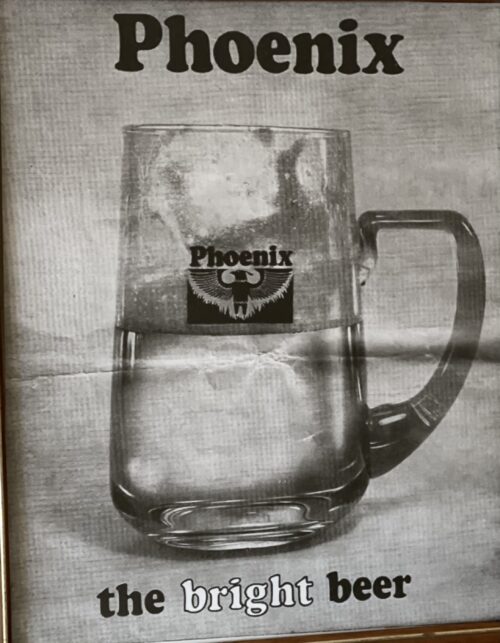
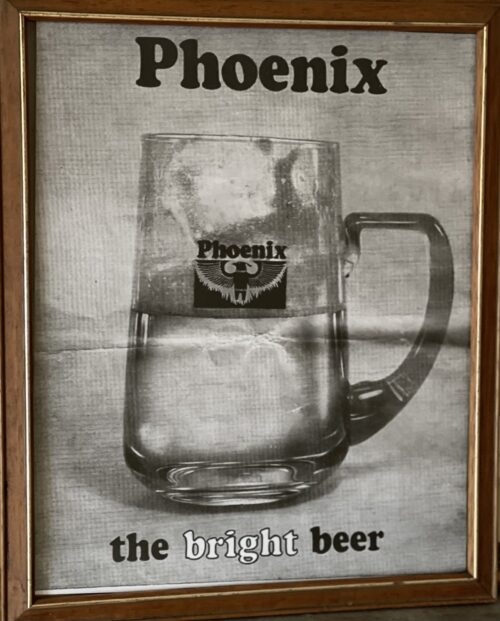 40cm x 35cm Phoenix Brewery (Dublin) Ltd, 89 James's Street, Dublin, Ireland. Founded 1778 and was later known as the Phoenix Porter Brewery Co. Registered January 1897. Acquired by John D'Arcy & Son Ltd 1906 and closed 1909. This brewery publicly advertised itself as "the largest brewery in Ireland but one". Founded in 1788 by Charles Madder who by all accounts was a brilliant technical and innovative brewer. He had come from London to brew porter in Dublin. His business and trading activities were poor and the brewery was rescued by one John Brennan and later his son Charles. Essentially a porter brewery with a capacity to produce 350,000 bulk barrels per annum, it launched its own O'Connell's Dublin Ale. This was probably due to the fact that when they took over Robert Manders & Co's Brewery, their next door neighbours in 1897 it replaced Mander's Dublin Ale. It enjoyed a local and export trade however for whatever the reasons it became bankrupt and closed in 1909. The franchise of brewing O'Connell's Dublin Ale was given to D'Arcys. From:- Breweries and Distilleries in Dublin Francis Coleman moved from 103 to 105 James Street on 15-8-1807. At that time Francis Coleman & Hamilton dissolved their brewing partnership. The Guinness Power station site (now Roe & Co distillery) near the corner of Watling Street occupied part of the site of the Phoenix brewery founded in 1778 by an English brewer called Mather. In 1828 John Brennan bought the brewery and was succeeded by Charles Brenan. Daniel O’Connell junior son of the Liberator acquired the Phoenix Brewery in 1831 which occupies a three acre site at the corner of Watling Street and James’s Street. It operated under the name O’Connell’s brewery for a time. There was a campaign to support their porter as “Catholic” against Guinnness’s “protestant porter“. Daniel O’Connell, the Liberator, refused to support that activity while he was an MP. Guinness was a political rival but was quite liberal on the Catholic Emancipation and Repeal questions. Phoenix acquired the adjoining the six acre Manders brewery site at 111-117 James’s Street and in 1897 the concern became a public company. The brewery extended from James Street to the Quays and had the second largest output in Ireland. John D'Arcy & Son Ltd’s Anchor Brewery bought the Phoenix brewery, then operating for 160 years on 13-6-1905 and it was hoped to continue both breweries as well as the Phoenix brand O’Connell’s ale. However by 13-10-1905 the Phoenix site was for auction.
40cm x 35cm Phoenix Brewery (Dublin) Ltd, 89 James's Street, Dublin, Ireland. Founded 1778 and was later known as the Phoenix Porter Brewery Co. Registered January 1897. Acquired by John D'Arcy & Son Ltd 1906 and closed 1909. This brewery publicly advertised itself as "the largest brewery in Ireland but one". Founded in 1788 by Charles Madder who by all accounts was a brilliant technical and innovative brewer. He had come from London to brew porter in Dublin. His business and trading activities were poor and the brewery was rescued by one John Brennan and later his son Charles. Essentially a porter brewery with a capacity to produce 350,000 bulk barrels per annum, it launched its own O'Connell's Dublin Ale. This was probably due to the fact that when they took over Robert Manders & Co's Brewery, their next door neighbours in 1897 it replaced Mander's Dublin Ale. It enjoyed a local and export trade however for whatever the reasons it became bankrupt and closed in 1909. The franchise of brewing O'Connell's Dublin Ale was given to D'Arcys. From:- Breweries and Distilleries in Dublin Francis Coleman moved from 103 to 105 James Street on 15-8-1807. At that time Francis Coleman & Hamilton dissolved their brewing partnership. The Guinness Power station site (now Roe & Co distillery) near the corner of Watling Street occupied part of the site of the Phoenix brewery founded in 1778 by an English brewer called Mather. In 1828 John Brennan bought the brewery and was succeeded by Charles Brenan. Daniel O’Connell junior son of the Liberator acquired the Phoenix Brewery in 1831 which occupies a three acre site at the corner of Watling Street and James’s Street. It operated under the name O’Connell’s brewery for a time. There was a campaign to support their porter as “Catholic” against Guinnness’s “protestant porter“. Daniel O’Connell, the Liberator, refused to support that activity while he was an MP. Guinness was a political rival but was quite liberal on the Catholic Emancipation and Repeal questions. Phoenix acquired the adjoining the six acre Manders brewery site at 111-117 James’s Street and in 1897 the concern became a public company. The brewery extended from James Street to the Quays and had the second largest output in Ireland. John D'Arcy & Son Ltd’s Anchor Brewery bought the Phoenix brewery, then operating for 160 years on 13-6-1905 and it was hoped to continue both breweries as well as the Phoenix brand O’Connell’s ale. However by 13-10-1905 the Phoenix site was for auction. -

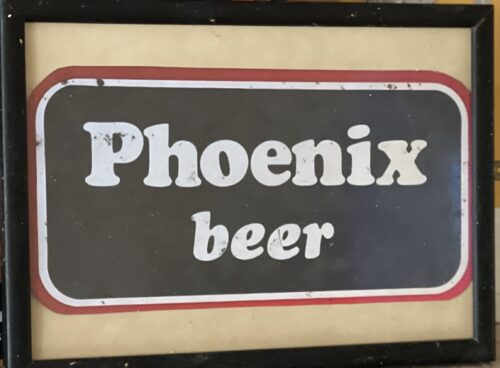 32cm x 27cm Phoenix Brewery (Dublin) Ltd, 89 James's Street, Dublin, Ireland. Founded 1778 and was later known as the Phoenix Porter Brewery Co. Registered January 1897. Acquired by John D'Arcy & Son Ltd 1906 and closed 1909. This brewery publicly advertised itself as "the largest brewery in Ireland but one". Founded in 1788 by Charles Madder who by all accounts was a brilliant technical and innovative brewer. He had come from London to brew porter in Dublin. His business and trading activities were poor and the brewery was rescued by one John Brennan and later his son Charles. Essentially a porter brewery with a capacity to produce 350,000 bulk barrels per annum, it launched its own O'Connell's Dublin Ale. This was probably due to the fact that when they took over Robert Manders & Co's Brewery, their next door neighbours in 1897 it replaced Mander's Dublin Ale. It enjoyed a local and export trade however for whatever the reasons it became bankrupt and closed in 1909. The franchise of brewing O'Connell's Dublin Ale was given to D'Arcys. From:- Breweries and Distilleries in Dublin Francis Coleman moved from 103 to 105 James Street on 15-8-1807. At that time Francis Coleman & Hamilton dissolved their brewing partnership. The Guinness Power station site (now Roe & Co distillery) near the corner of Watling Street occupied part of the site of the Phoenix brewery founded in 1778 by an English brewer called Mather. In 1828 John Brennan bought the brewery and was succeeded by Charles Brenan. Daniel O’Connell junior son of the Liberator acquired the Phoenix Brewery in 1831 which occupies a three acre site at the corner of Watling Street and James’s Street. It operated under the name O’Connell’s brewery for a time. There was a campaign to support their porter as “Catholic” against Guinnness’s “protestant porter“. Daniel O’Connell, the Liberator, refused to support that activity while he was an MP. Guinness was a political rival but was quite liberal on the Catholic Emancipation and Repeal questions. Phoenix acquired the adjoining the six acre Manders brewery site at 111-117 James’s Street and in 1897 the concern became a public company. The brewery extended from James Street to the Quays and had the second largest output in Ireland. John D'Arcy & Son Ltd’s Anchor Brewery bought the Phoenix brewery, then operating for 160 years on 13-6-1905 and it was hoped to continue both breweries as well as the Phoenix brand O’Connell’s ale. However by 13-10-1905 the Phoenix site was for auction.
32cm x 27cm Phoenix Brewery (Dublin) Ltd, 89 James's Street, Dublin, Ireland. Founded 1778 and was later known as the Phoenix Porter Brewery Co. Registered January 1897. Acquired by John D'Arcy & Son Ltd 1906 and closed 1909. This brewery publicly advertised itself as "the largest brewery in Ireland but one". Founded in 1788 by Charles Madder who by all accounts was a brilliant technical and innovative brewer. He had come from London to brew porter in Dublin. His business and trading activities were poor and the brewery was rescued by one John Brennan and later his son Charles. Essentially a porter brewery with a capacity to produce 350,000 bulk barrels per annum, it launched its own O'Connell's Dublin Ale. This was probably due to the fact that when they took over Robert Manders & Co's Brewery, their next door neighbours in 1897 it replaced Mander's Dublin Ale. It enjoyed a local and export trade however for whatever the reasons it became bankrupt and closed in 1909. The franchise of brewing O'Connell's Dublin Ale was given to D'Arcys. From:- Breweries and Distilleries in Dublin Francis Coleman moved from 103 to 105 James Street on 15-8-1807. At that time Francis Coleman & Hamilton dissolved their brewing partnership. The Guinness Power station site (now Roe & Co distillery) near the corner of Watling Street occupied part of the site of the Phoenix brewery founded in 1778 by an English brewer called Mather. In 1828 John Brennan bought the brewery and was succeeded by Charles Brenan. Daniel O’Connell junior son of the Liberator acquired the Phoenix Brewery in 1831 which occupies a three acre site at the corner of Watling Street and James’s Street. It operated under the name O’Connell’s brewery for a time. There was a campaign to support their porter as “Catholic” against Guinnness’s “protestant porter“. Daniel O’Connell, the Liberator, refused to support that activity while he was an MP. Guinness was a political rival but was quite liberal on the Catholic Emancipation and Repeal questions. Phoenix acquired the adjoining the six acre Manders brewery site at 111-117 James’s Street and in 1897 the concern became a public company. The brewery extended from James Street to the Quays and had the second largest output in Ireland. John D'Arcy & Son Ltd’s Anchor Brewery bought the Phoenix brewery, then operating for 160 years on 13-6-1905 and it was hoped to continue both breweries as well as the Phoenix brand O’Connell’s ale. However by 13-10-1905 the Phoenix site was for auction.

